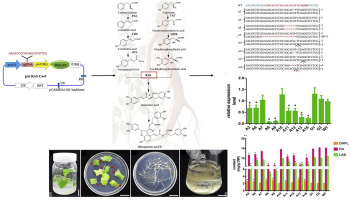当前位置:
X-MOL 学术
›
Phytochemistry
›
论文详情
Our official English website, www.x-mol.net, welcomes your feedback! (Note: you will need to create a separate account there.)
CRISPR/Cas9-mediated efficient targeted mutagenesis of RAS in Salvia miltiorrhiza
Phytochemistry ( IF 3.8 ) Pub Date : 2018-04-01 , DOI: 10.1016/j.phytochem.2018.01.015 Zheng Zhou 1 , Hexin Tan 1 , Qing Li 2 , Junfeng Chen 2 , Shouhong Gao 2 , Yun Wang 2 , Wansheng Chen 2 , Lei Zhang 1
Phytochemistry ( IF 3.8 ) Pub Date : 2018-04-01 , DOI: 10.1016/j.phytochem.2018.01.015 Zheng Zhou 1 , Hexin Tan 1 , Qing Li 2 , Junfeng Chen 2 , Shouhong Gao 2 , Yun Wang 2 , Wansheng Chen 2 , Lei Zhang 1
Affiliation

|
The CRISPR (Clustered Regularly Interspaced Short Palindromic Repeats)/Cas9 (CRISPR-associated) system is a powerful genome editing tool that has been used in many species. In this study, we focused on the phenolic acid metabolic pathway in the traditional Chinese medicinal herb Salvia miltiorrhiza, using the CRISPR/Cas9 system to edit the rosmarinic acid synthase gene (SmRAS) in the water-soluble phenolic acid biosynthetic pathway. The single guide RNA (sgRNA) was designed to precisely edit the most important SmRAS gene, which was selected from 11 family members through a bioinformatics analysis. The sequencing results showed that the genomes of 50% of the transgenic regenerated hairy roots had been successfully edited. Five biallelic mutants, two heterozygous mutants and one homozygous mutant were obtained from 16 independent transgenic hairy root lines when the sgRNA was driven by the Arabidopsis U6 promoter, while no mutants were obtained from 13 independent transgenic hairy root lines when the sgRNA was driven by the rice U3 promoter. Subsequently, expression and metabolomics analysis showed that the contents of phenolic acids, including rosmarinic acid (RA) and lithospermic acid B, and the RAS expression level were decreased in the successfully edited hairy root lines, particularly in the homozygous mutants. In addition, the level of the RA precursor 3,4-dihydroxyphenyllactic acid clearly increased. These results indicated that the CRISPR/Cas9 system can be utilized to identify important genes in a gene family with the assistance of bioinformatics analysis and that this new technology is an efficient and specific tool for genome editing in S. miltiorrhiza. This new system presents a promising potential method to regulate plant metabolic networks and improve the quality of traditional Chinese medicinal herbs.
中文翻译:

CRISPR/Cas9介导的丹参RAS高效靶向诱变
CRISPR(Clustered Regularly Interspaced Short Palindromic Repeats)/Cas9(CRISPR 相关)系统是一种强大的基因组编辑工具,已在许多物种中使用。本研究以中药丹参中的酚酸代谢途径为研究对象,利用CRISPR/Cas9系统对水溶性酚酸生物合成途径中的迷迭香酸合酶基因(SmRAS)进行编辑。单向导 RNA (sgRNA) 旨在精确编辑最重要的 SmRAS 基因,该基因是通过生物信息学分析从 11 个家族成员中选出的。测序结果显示,50%的转基因再生毛状根基因组已被成功编辑。五个双等位基因突变体,当sgRNA由拟南芥U6启动子驱动时,16个独立的转基因毛根系获得了2个杂合突变体和1个纯合突变体,而当sgRNA由水稻U3启动子驱动时,13个独立的转基因毛根系没有获得突变体。随后,表达和代谢组学分析表明,在成功编辑的毛根系中,包括迷迭香酸(RA)和紫精酸B在内的酚酸含量和RAS表达水平降低,特别是在纯合突变体中。此外,RA前体3,4-二羟基苯基乳酸的含量明显增加。这些结果表明,CRISPR/Cas9系统可用于在生物信息学分析的帮助下识别基因家族中的重要基因,这项新技术是一种高效且特异性的丹参基因组编辑工具。这一新系统为调节植物代谢网络和提高中药材质量提供了一种很有前景的潜在方法。
更新日期:2018-04-01
中文翻译:

CRISPR/Cas9介导的丹参RAS高效靶向诱变
CRISPR(Clustered Regularly Interspaced Short Palindromic Repeats)/Cas9(CRISPR 相关)系统是一种强大的基因组编辑工具,已在许多物种中使用。本研究以中药丹参中的酚酸代谢途径为研究对象,利用CRISPR/Cas9系统对水溶性酚酸生物合成途径中的迷迭香酸合酶基因(SmRAS)进行编辑。单向导 RNA (sgRNA) 旨在精确编辑最重要的 SmRAS 基因,该基因是通过生物信息学分析从 11 个家族成员中选出的。测序结果显示,50%的转基因再生毛状根基因组已被成功编辑。五个双等位基因突变体,当sgRNA由拟南芥U6启动子驱动时,16个独立的转基因毛根系获得了2个杂合突变体和1个纯合突变体,而当sgRNA由水稻U3启动子驱动时,13个独立的转基因毛根系没有获得突变体。随后,表达和代谢组学分析表明,在成功编辑的毛根系中,包括迷迭香酸(RA)和紫精酸B在内的酚酸含量和RAS表达水平降低,特别是在纯合突变体中。此外,RA前体3,4-二羟基苯基乳酸的含量明显增加。这些结果表明,CRISPR/Cas9系统可用于在生物信息学分析的帮助下识别基因家族中的重要基因,这项新技术是一种高效且特异性的丹参基因组编辑工具。这一新系统为调节植物代谢网络和提高中药材质量提供了一种很有前景的潜在方法。


























 京公网安备 11010802027423号
京公网安备 11010802027423号